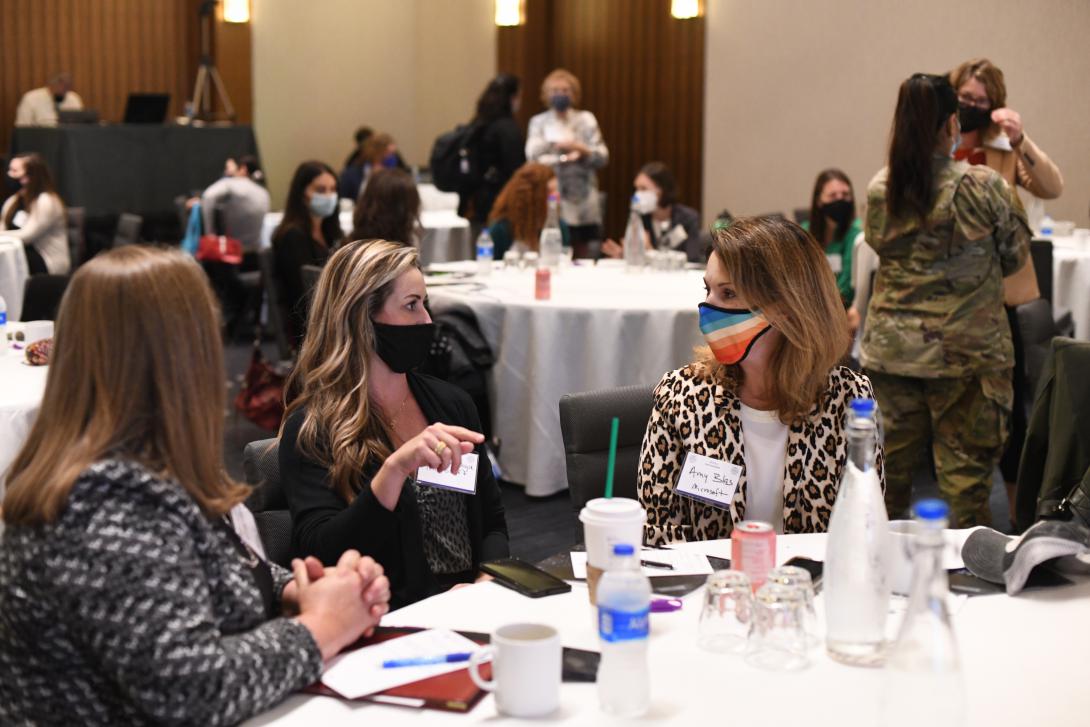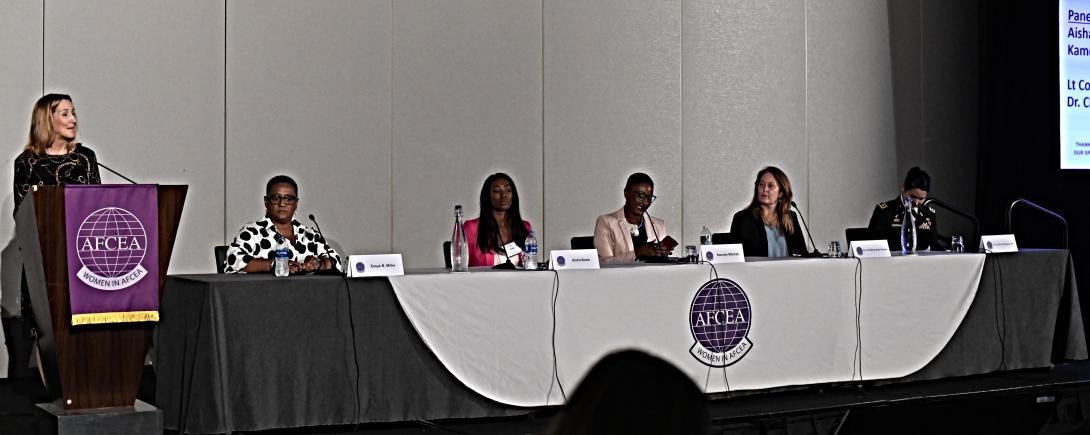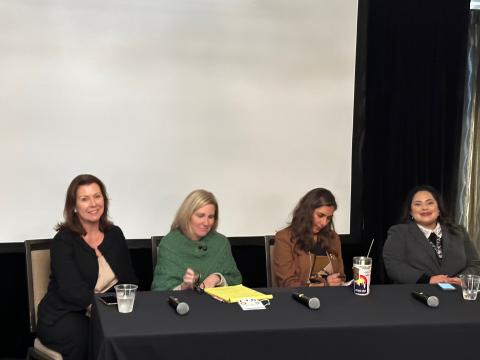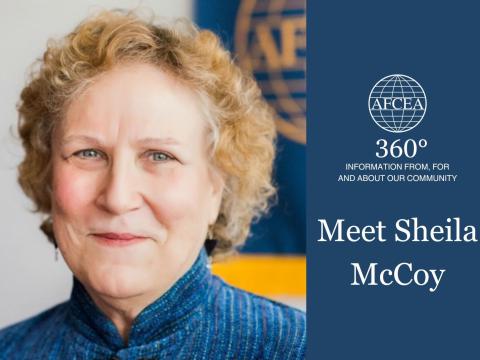Journeys To Bridge The Gender Divides in STEM
Empowering women in the workplace has certainly improved over the past several decades, it’s still not enough—especially when it comes to ensuring girls aspiring for STEM have the opportunities and support to reach those goals, panelists share.
While attitudes and practices that empower women in the workplace have certainly improved over the past several decades, it’s still not enough—especially when it comes to ensuring girls aspiring to careers in math and sciences have the opportunities and support to reach those goals.
Such was the consensus Wednesday during an afternoon of speeches and panel discussions at the second annual AFCEA Women in the Workforce: A Journey in STEM conference addressing the challenges professional women in science, technology, engineering and mathematics (STEM) face, and the solutions to break down those barriers.
The second- and third-order effects of empowering women and minorities extend well beyond helping individuals achieve their career goals, said Lt. Gen. Mary O’Brien, USAF, deputy chief of staff for Intelligence, Surveillance, Reconnaissance and Cyber Effects Operations for the U.S. Air Force.
Be on the lookout … Data biases could drastically skew development of #AI and algorithms, @USAF_26 Lt. Gen. Mary O’Brien shares citing book/research at @AFCEA #WomeninSTEM event.
— Sandra Jontz (@SandraJontz) September 1, 2021
Cultural and gender diversity foster innovation and efficiencies important for national security, for economic stability and even for medical advances—the latter evidenced by the recent development of the vaccine to combat the coronavirus disease, said Gen. O’Brien, who delivered the event’s keynote address.
Yet for all the known benefits of championing diverse and inclusive workplace environments, a profusion of unknowns still presents challenges that keep women, in particular, from both entering and staying in STEM careers, Gen. O’Brien said.
For example, of the women who enter college planning to major in STEM-related fields, 49 percent change their majors midstream, compared to 32 percent of men, Gen. O’Brien said. “What changes? Why does that happen?” she asked. “Don’t hold your breath waiting for me to give you an answer. I don’t know.”
Did you know? Women enter college wanting to major in #STEM. 49% change course, compared to 32% of men, @USAF_A26 shares at #WomeninSTEM. ‘Why is that?’ pic.twitter.com/SKZOFwX47p
— Sandra Jontz (@SandraJontz) September 1, 2021
Yet the answers lie in challenging assumptions, she offered, and making cultural shifts that put males and females on equal footing in school and beyond. “Why is it OK for our sons to study science, but it’s too hard for our daughters?” she asked of a common bias, sharing recollections of her childhood and her pursuit of a chemistry degree.
Today, whether she’s gardening with her grandchildren or teaching them the properties of physics while using stomp rockets in the cul-de-sac, talking science is part of their everyday vernacular and lives. “The more we normalize science in our lives, it doesn’t become a foreign thing that you only do in labs with goggles,” Gen. O’Brien said.
Igniting Interest and Keeping the Passion Alight
The question of gaining and keeping girls’ attention in STEM fields fueled a panel discussion moderated by Essye Miller, who recently retired as principal deputy chief information officer at the Defense Department.
Part of that answer lies in challenging the status quo and addressing issues head-on, especially the difficult ones, Miller said. “We have to find the moral courage to have the tough conversations,” she said. “We have an opportunity to shift the conversation, to enact change. We just have to step into it.”
Essye Miller, retired @DeptofDefense Principal Deputy #CIO is a self- described introvert who, to become the leader she is today, struggled to ‘find her voice.’ And what a voice! #WomeninSTEM pic.twitter.com/GY1gb0R8fu
— Sandra Jontz (@SandraJontz) September 1, 2021
That isn’t always easy, especially for introverts or those who shy away from any kind of spotlight, Miller said. But enacting change means stepping out of a comfort zone and “finding your voice,” whether as a leader, an advocate, a peer, a teacher, a boss or a friend, Miller said.
Empowerment in the form of cultural changes is never easy, but change doesn’t need to be mammoth. Adjustments can come from small steps and advancements, offered Christine Anne Royce, professor of teacher education at Shippensburg University in Pennsylvania. What if, instead of asking young women to list positives and negatives of any given situation, they were asked to offer positives and "deltas," or aspects they wanted to change, inquired Royce, highlighting that a tiny tweak in an approach can elicit a mighty change for the better.
Opening the Aperture for Change
While on the surface it might seem counterintuitive that promoting non-STEM-related careers helps foster interest and retention in the much-needed STEM disciplines, the opposite is proving true, suggested Quiana Smith, growth strategy and innovation executive at EY. “It’s important to expand that lens” and understand that empowering women in careers such as business administration, acquisition, program management and more are equally valuable. “We need to help change the narrative, and that there are vast opportunities.”
It’s important to create communities and environments where #women can let down their walls & learn from one another, says @Quiana_Smith, joined by panelists Dr. Abigail Haddad & Lt. Col. Nadine Nally & Amy Jones (not pictured). @AFCEA #WomeninSTEM pic.twitter.com/wQM0amLkMC
— Sandra Jontz (@SandraJontz) September 1, 2021
Opening the aperture also means meeting non-career-centric needs, such as adequate maternity leave or appropriating accommodations for nursing mothers who return to work after giving birth, said panelists Abigail Haddad, a data scientist with the U.S. Army Financial Management and Comptroller, and Lt. Col. Nadine Nally, USA, director for defense innovation and cyber policy for the Defense Directorate at the National Security Council.
Successes Emerge From Different Career Journeys
The event concluded with tips, tricks and advice proffered by renowned female leaders in the defense and industrial base who shared their journeys to their career pinnacles. Lt. Gen. Susan Lawrence, USA (Ret.), started as a stenographer and became a leader in defense information technology and communications systems, and today is managing director in national security practice at Accenture Federal Services.
Miller, who sat on two panels Wednesday and began her career wanting to be a certified public accountant, said her “career chose her,” but she knew when to say no to superiors when opportunities didn’t align with her work/family balance objectives.
Angel Smith, senior director for Azure Global Mission 360 at Microsoft and a former tanker pilot with the U.S. Marine Corps and a Capitol Hill influencer, was in the driver seat of her career and vowed to be authentic and true to herself.
Life lesson: get outside of your management realm and #network, advises @Oracle Tamara Greenspan during @AFCEA #WomeninSTEM conference pic.twitter.com/3sOw38hKXf
— Sandra Jontz (@SandraJontz) September 1, 2021
And in what is considered today an anomaly in that she stayed at one company for many years, Tamara Greenspan has been at Oracle for 32 years and measures her success by excelling not just at her job as group vice president and general manager for public sector application but as a working mother of three, a wife, a friend and the leader of the nonprofit KINDH, or Kids in Need During the Holidays, which provides underprivileged children in counties in Maryland and Virginia with memorable holiday experiences.
Each panelist advised attendees to leverage the power of authenticity, to raise your hand and be present at work functions, to advocate for yourself and to find and rely on a support system. Each detailed their unique, funny and inspiring journeys. And each revealed a common thread woven throughout their tapestries of success: they didn’t do it alone.






Comments